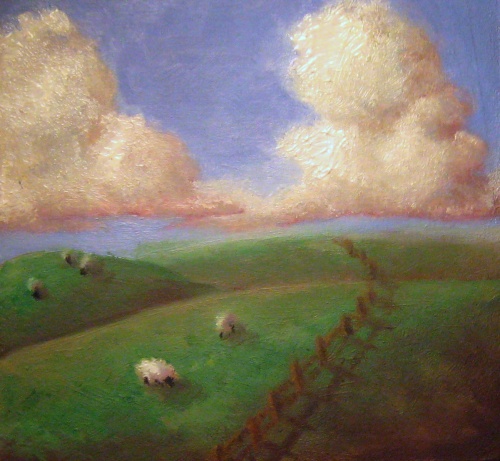Once again, as part of my science and art class (which is now finished btw) we spent some time becoming familiar with different kinds of paint. This tiny little piece is my very first time working with oil paint! This panel is only 4″x4″ and has been gesso’d and sanded by hand.
Oil paint is a mixture of raw pigments and linseed oil. (Or poppy seed oil or walnut oil, but linseed is most commonly used today) We mixed all of our own pigments to paint these little panels, and a small amount of color really goes a long way. Mostly because oil paint stays wet for so long, small bits of pigment can be re-worked and blended for days. Many people who work with oil consider this feature to be one of its greatest advantages. I however, am not quite used to it yet. I am used to layering my paint in rapid succession using acrylics which dry very quickly. Acrylic paints have really dictated the way that I learned to paint because oils had not been very available to me in high school. Another draw back to oil paints that I see, is actually what I smell. The image dries on the canvas as the linseed oil goes rancid. Therefore, the linseed oil gives off a strong odor which gives painting studios a distinctive smell. I am not a fan.

Linseed oil apparently is always drying. And practically never stops. If you pour a little on a pallet and let it sit for months, it will dry into a rubbery substance sort of like dried glue or rubber cement but with less crumbling. If left for enough years, the oil will harden into a rock and can be shattered.
Oil paints can be toxic, especially if you inhale the unmixed pigments, but some materials are more dangerous than others. Watch out for cadmium and lead.
Oils are very good for dark paintings, and soft blended transitions from dark to light. Rich, deep, darks can be created from oils because of the natural sheen of the paint. The paint is also slightly translucent, allowing some of the underpainting to glow through. The translucency of oil paint can be compared to that of skin, making it an excellent medium for portraits.
I am not ready for oil portraits. Compared to acrylics the paint seems slippery and the continuous smudging of areas I had already completed was frustrating. Lots of drying time must be allowed before areas can be reworked. I spent two sessions of 2 hours per session on this little piece, with 3 days in between for the paint to dry. Even then, there was still wet paint on the sides of the panel. After all is said and done, the glow of this little painting is nice in person, and it has a strong atmospheric quality which was surprisingly easy to achieve thanks to the paint’s luminosity. I look forward to gaining more practice with oils, but in the future I will likely be buying my pigments in tubes instead of the raw form.
